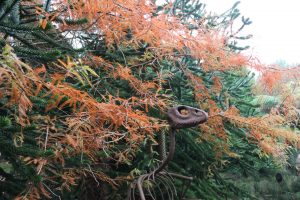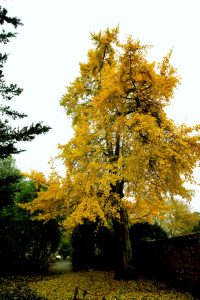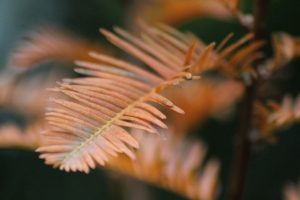By Andy Winfield
When we think of conifers many things spring to mind. The tall straight evergreen woodlands, North American giants, a festive winter addition to the house or Cypress punctuating Mediterranean skies; pinecones sitting in the crook of a tree or resinous smells drifting in a cool still air. These are all true of conifers, but let’s give some love to deciduous conifers, some of the shining stars of autumn.
Autumn has been beautiful this year, it’s taken a little while to get going, but when it did the colour was dazzling. Acers burning bright like a flash fire before going out just as quickly, Beech trees with their familiar russet carpet and the custard yellow of a tulip tree have been highlights in the Garden this year; but favourites of mine are always deciduous conifers. They never fail, there must be something about the tightly packed needles that give the autumn colour a depth that is unique.
In the Botanic Garden we have deciduous conifer species that can be breath-taking, but I’ll start with one we don’t have (yet), the larch. This tree possesses my favourite of all autumn colour, the tall less ordered habit is transformed through natural alchemy into a gilded masterpiece. Introduced in the 1600s for its wood, there are two varieties in the UK, Japanese (Larix kaempferi) and European larch (Larix decidua). Larch grows in cold cold places, like Siberia and Canada, places that light up in autumn with the golden glow of these trees. In this country we don’t see them on such a scale but bumping into them on a walk is a real treat. Invisible at other times of year, an introvert not seeking the limelight, in autumn they’re conspicuous yellow towers smiling downwards and looking fabulous.

Here in the Garden the bald cypress, Taxodium distichum, is in its full autumn cloak; it’s growing in the Evolution of Land Plants display behind our resident dinosaur rustisaurus. They work very well together, the burnt orange foliage of the cypress hanging around rusti’s neck like a feather boa. This plant is native to a very different environment from the larch; as the name suggests, it grows in swamps from Texas to Florida and is the state tree of Louisiana. The climate is warm and humid and there is a distinct lack of nutrients in the soil which could be why it sheds leaves in autumn; it’s been growing in this way for millions of years and petrified remains of ancient woodlands can be found throughout the US southern states, even under the oceans. In the Garden the colour complements a blue sky and is enlivened by bright autumn days; it’s a plant that is well capable of stopping me in my tracks.

Talking of which, another conifer that can cause an intake of breath is our Ginkgo in the traditional Chinese Herb Garden. This is a tree with a mythical quality, there’s something of the golden fleece about it. The area around it is transformed with its majestic ambience, the leaves, individually striking and collectively spectacular, drip from the branches forming a pool of colour around the base of the trunk. In China ancient trees are found in Buddhist Temples with one in the Zhongnan Mountains over 1,400 years old, enthralling visitors with a vibrant leaf drop every year. Perhaps the fact that ginkgo is one of the oldest living tree species give it extra authority, a calm reassurance that it knows what it’s doing. There have been around 245 million autumns with ginkgo on the planet; it has seen dinosaurs come and go and still methodically sees each year out with a sparkling display amongst the young upstarts of acer and beech.

Another ancient deciduous conifer is the dawn redwood, Metasequoia glyptostroboides. This plant was thought to be extinct until it was discovered growing in China in the 1940s; it can now be found extensively and brightens autumn with an amber glow. Ours in the Garden is still very young; to see the autumn colour we need to part the ferns it’s planted amongst, but in time it will joining the other deciduous conifers in brightening up the Garden’s autumn palette.

